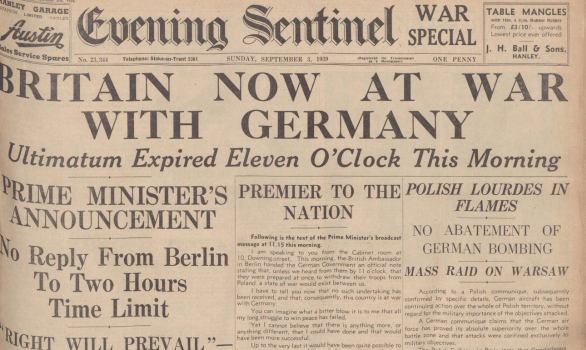Why can researching WWII ancestors be so challenging? Military Genealogist Simon Pearce tackles the question and provides advice on how to make meaningful discoveries.
Intro
Many of us have family members who served during WWII. They may have flown with the Royal Air Force during the Battle of Britain, worked on anti-aircraft batteries with the Auxiliary Territorial Service (ATS), served at sea with the Royal or Merchant Navy during the Battle of the Atlantic or landed on the beaches of Normandy during the D-Day invasion. Why, then, is it so challenging to research our WWII ancestors? I’m lucky to interact regularly with the Forces War Records (FWR) community via our social media channels, and these difficulties are regularly highlighted in our conversations.
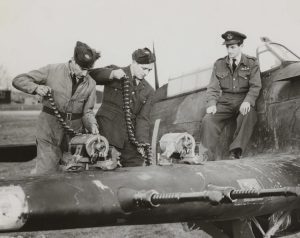
The challenges when researching WWII ancestors
In reality, WWII was not that long ago and is still in living memory for some, while the number of surviving veterans dwindles yearly. The relatively close proximity of the war to the present day is one obstacle when researching WWII ancetsors. Military records can contain sensitive information, like medical reports. They often detail a person’s next of kin, address and details of any children. As a result, certain records are not widely available, owing to UK data protection laws, and access is sometimes only granted to the next of kin (this can depend on the person’s age). In some instances, a 100-year rule, or longer, has been imposed, where the record cannot be released until 100 years, or longer, after the person’s birth. This directly impacts a key source for researching our military ancestors – service records. A service record is undoubtedly the most valuable source for researching WWII ancestors. While the content of a service record differs across the various branches of the armed forces, they may indicate when and where your ancestor enlisted, who they served with, their promotions, if they were wounded and the medals they were entitled to. At the time of writing, we do not have online access to WWII service records as we do for WWI or previous wars. This makes it very difficult to gain instant information about our military ancestors and even harder to narrow results in other collections when you have no prior knowledge of your ancestors’ service. As mentioned previously, a service record will often detail a person’s date and place of birth or address and next of kin information; these unique details help you to identify your ancestor with greater ease. This information can help you confidently locate them in other collections where only limited information is provided. Without a service record or prior knowledge of your ancestors’ service, it can be almost impossible to identify your ancestor in other military collections, especially if they have a popular name. More on service records shortly.
Begin your search with Forces War Records
We appreciate that many of you will start your searches from different levels of experience. Some will know nothing of their ancestors’ service, while others will have a few clues or detailed information, like a number and a regiment. Despite the difficulties surrounding WWII research, it is worth beginning your search on Forces War Records. We have a wide range of records available, from medal and casualty collections to prisoner of war records and nominal rolls. If you’re new to Forces War Records, we’ve created a handy video to help you get started with your searches. You can browse all our collections and search them by keyword here.
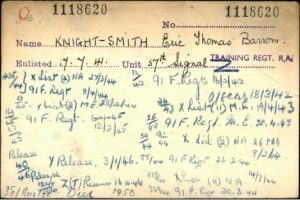
FWR Tip: Broaden your searches and look for indirect ancestors like aunts and uncles or great-aunts and great-uncles, giving you a greater chance of finding more military ancestors. Still no trace of your ancestor after searching? Not to worry, this is quite common.
The ‘no trace’ ancestors
Some people simply don’t show up in the records. My great-grandfather served in Burma (now Myanmar) with the Royal Engineers during WWII but does not appear in any online records. He was sent overseas and did his bit, and I have many of his letters containing useful clues. But when I searched for him online, it felt like he didn’t exist, and this may be an experience you’ve had too. This is a common occurrence when researching WWII ancestors. One collection that can make all the difference is the WW2 army medal cards.
WWII British Army Medal Cards
The WW2 army medal cards are application cards, known as C.S. 20, which soldiers of the British Army and other units administered by the War Office could fill out and send to the War Office after the war to claim the campaign medals they were entitled to for their WW2 service. The collection contains many examples of medal cards completed by a service person’s next-of-kin.
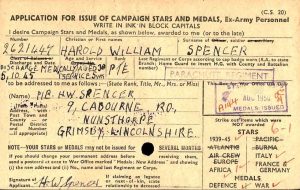
The medal cards indicate the campaign medals your ancestor was entitled to for their service during WW2. This could have been the France and Germany Star for their service in North West Europe or the Burma Star for participating in the brutal Burma Campaign, amongst others listed on the cards.
Aside from medal entitlement, the cards offer family historians vital clues for researching a military ancestor: the service person’s name, rank, number, last regiment, and discharge date. The person’s address and sometimes age are also featured on the card. You’ll also see the service person’s signature, which adds a poignant, personal element to the cards.
FWR Tip: Our blog provides a detailed guide on how to use the WWII army medal cards.
Service records
As we have previously discussed, a service record is the most important record for researching WWII ancestors. But where can we find a WWII service record? The Ministry of Defence (MOD) has been the long-term custodian of WWII service records. Whether your ancestor served with the army, navy, or air force, was in the women’s services like the Auxiliary Territorial Service (ATS) or was a military nurse, their service record will be a vital source in your research. Knowing where to go for service records is important, especially as certain records have been and are in the process of being transferred from the MOD to The National Archives (TNA) in Kew. The following guide should help to pinpoint where the records are held:
- British Army other ranks – TNA
- British Army officers – MOD
- Royal Navy – MOD
- RAF – MOD
- Auxiliary Territorial Service – TNA
- Women’s Royal Naval Service – MOD
- Women’s Auxiliary Air Force – MOD
- Military nursing services – MOD
- Red Cross – British Red Cross Museum and Archives
For records held by the MOD, you can apply online for an ancestor’s WWII service record via the MOD website. TNA has created two online ordering forms: one for records where the individual is presumed to be deceased or was born more than 115 years ago and one for where the individual is presumed still living, or was born fewer than 115 years ago.
FWR Tip: In March 2023, Ancestry® announced that it was awarded the exclusive rights to digitise and publish more than three million Ministry of Defence service records by The National Archives. These service records cover military personnel who were discharged from the British Army from 1921 onwards. The first tranche of records is expected to be available on Ancestry® from 2024, with the full digitisation of all records in the collection planned for completion in 2029.
Ancestry® WWII service records
In November 2024, Ancestry® added the first tranche of service records, covering post-1921 and WWII. These collections are as follows:
UK, Royal Electrical and Mechanical Engineers Service Records, 1942-1959
UK, Selected Smaller Units Service Records, 1921-1959, including units such as the Army Air Corps, Royal Army Veterinary Corps, Royal Military Police and the Royal Army Pay Corps, plus others.
Only records of service members born over 100 years ago have been published, with more released annually as they exceed 100 years since birth.
Service records – next steps
There can be a lot of information to take in when studying an ancestor’s service record. One of the advantages of a service record is that certain pages allow us to track the movements of our ancestors. Regardless of whether it’s a battalion in the army, a squadron in the RAF or a ship in the navy, a service record should detail an ancestor’s movements from one unit to another, complete with dates and sometimes their ranks. This is an important process; not only does it allow us to piece together a timeline of our ancestor’s service, but it will also help us later down the line when we turn our attention to contextual records to find out what they were experiencing on particular dates.
Contextual records
For many of us researching WWII ancestors, the goal may be to understand their wartime service in greater detail. Perhaps you want to learn what everyday life was like for their unit or what they did during a particular battle or campaign. Excitingly for us military genealogists, contextual records are available that help us delve deeper into our ancestors’ service. Let’s break it down service by service:
British Army War Diaries
The records you are looking for if your ancestor served with the British Army are war diaries. They provide a day-to-day account of a battalion or unit’s activities, often naming officers and occasionally other ranks. War diaries are great for understanding what your ancestor’s unit was experiencing on a particular date. This could be day-to-day service, actions during a battle or what was happening on the date they were wounded, killed or awarded for bravery. WWII war diaries are held at The National Archives, but some are also available via Ancestry’s® UK, World War II War Diaries, 1939-1946 and UK, D-Day War Diaries and Photographs, 1944 collections.
Operations Record Books
Operations Record Books (ORB) cover the daily actions, missions and sorties of the Royal Air Force. They often name pilots and aircrew and provide fascinating information like the aircraft your ancestor was operating, the times they set off and the actions they were involved in.
Ship’s Logs
If you wish to learn more about the service of your naval ancestors, check out the ship’s logs. These were maintained by the Officer of the Watch and provided a daily account of the ship’s activities. They are less detailed than war diaries or ORBs, but still offer an interesting insight into a ship’s movements and actions. Ship’s logs and submarine logs are available from TNA. FWR Tip: Most of the time, you will need your ancestor’s service record to work out the unit they were serving with before turning to contextual records. You may, however, know who your ancestor was serving with when they died, but their service record is one of the few sources that will tell you when they joined the unit, ship or squadron.
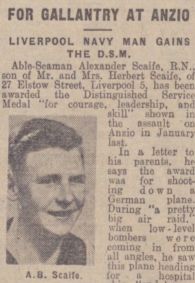
Other contextual sources Our Historical Documents Library contains publications from magazines to regimental histories and can help you when researching WWII ancestors. These, too, can provide helpful insight into your ancestor’s wartime experiences.
Using newspapers to research WWII ancestors
Don’t forget to search newspapers. Newspapers are a valuable source for researching military ancestors. You may encounter obituaries detailing a veteran’s military service or an article noting they had enlisted. During both world wars, newspapers were full of military articles. Sometimes you’ll find photos of service people, extracts of their letters, details of their capture or casualty lists recording the wounded, missing and, sadly, the dead.
There are many collections available on Forces War Records to help you learn more about your military ancestors. You can view all our records via the Browse tab, with options available to narrow the collections by country, theatre of war or service branch.
We’re always here for you if you need help or advice with your research. Why not follow us on Facebook and submit a question to one of our monthly military genealogy Q&As? You can also send a query via the Document Expert section of our website.
Cover image: © Newspapers.com

